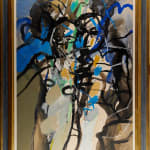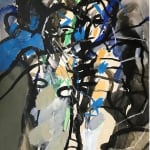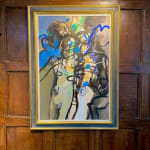Keith Vaughan
Maze of Figures, circa 1973-5
watercolour and gouache
77 x 53 cm
30 1/4 x 20 7/8 in
30 1/4 x 20 7/8 in
Further images
'The true heir of Cezanne, at his most profound, most ambitious, most difficult' Alan Bowness, British art historian, art critic, and Director of the Tate Gallery (1980 - 1988), speaking...
'The true heir of Cezanne, at his most profound, most ambitious, most difficult'
Alan Bowness, British art historian, art critic, and Director of the Tate Gallery (1980 - 1988), speaking about Keith Vaughan
Keith Vaughan (1912-1977) is one of the best known and widely collected artists of the British Neo-Romantic movement alongside his friend John Minton. Born in 1912, he did not attend art school, but received a thorough grounding in Italian Renaissance painting at Christ's Hospital, and then from 1931-38 whilst working for the advertising agency, Lintas and painted in his spare time. He was greatly influenced by the work of Henry Moore and Graham Sutherland, but also followed European avant-garde trends. His admiration for the artist, Nicholas de Steal (1914-1955) was of particular importance.
Vaughan travelled widely in the post-war period, visiting the Mediterranean, North Africa, Mexico and the USA. He became resident artist at Iowa State University in 1959. Vaughan taught in London at Camberwell School of Art (1946–8) and the Central School of Arts and Crafts (1948–57) and was a visiting teacher at the Slade School of Fine Art (1959–77).
He was widely respected by his peers and the establishment and was awarded a CBE for services to the arts, but he remained a melancholic figure somewhat tortured by his own sexuality. His work has been collected by most major public collections of British art, including the Tate, Arts Council, Contemporary Art Society, Victoria & Albert Museum, Fitzwilliam Museum in Cambridge, Auckland Museum in New Zealand and the Art Institute of Chicago, and has been the subject of a number of major museum exhibitions including a retrospectives at the Whitechapel Gallery in 1962 and the University of York in 1970. The centenary of Keith Vaughan's birth was celebrated with an exhibition at Pallant House Gallery in Chichester, 'Keith Vaughan: Romanticism to Abstraction' (10 March-10 June 2012).
Vaughan is best known for his figure paintings and drawings, particularly of male nudes. Whilst his painting is resolutely figurative, he engaged directly with abstraction. However, Vaughan never considered himself to be an abstract painter and wrote in his journal in January 1954: “Abstraction seems the way out for most other painters. But I cannot regard it as a solution. The language of “pure” form is too subjective.” Maze of Figures achieves a satisfying balance between figuration and abstraction, since his imagery operates successfully on both levels as portrait heads and various figure silhouettes are simultaneously superimposed into a single composition of interpenetrating realities.
Gerard Hastings, a leading scholar on the life and work of Keith Vaughan describes Vaughan's process: "When starting a gouache Vaughan would make a series of automatic, random marks on the paper. These unconscious smudges and splashes were sometimes incorporated into the structural design of the composition, as in Maze of Figures, or obliterated as the painting evolved; either way, they kick-started the painting process for him. It was an intuitive ritual that started ‘…as usual, with no more than a process. The making of a series of wet marks across the white board in a sequence of colours (blue black I fancy at the moment) and see where it leads’, (Keith Vaughan, Journal, July 2, 1972). He then used black Indian ink to augment the arbitrary arrangement of emerging forms, letting the easy flow of his brush and his instinctive pictorial handwriting guide his gestures until more formal configurations began to emerge... Often, as I’m sure to be the case here, blank, unworked areas of paper supply the lightest tones. His open, fluid brushwork operates a little like calligraphic techniques - producing highly spontaneous and serpentine, linear forms.
Structuring the composition was vital. In studio notebooks he recorded the progress of his paintings from the initial marks to the final touches. One note reads: ‘Necessity for compositional structure to run right through to the edges – disregarding identity of forms… not enough simply to balance shapes within the area. This is a subjectively obvious fact of which I have only just become conscious in words… the continuing lines are never obvious and are constantly interrupted by counter rhythms and thrust back and forth in space’ (Keith Vaughan: unpublished Notes on Painting, October 16, 1958). His pictorial scaffolding gradually transformed itself into contours of interlocking heads, shoulders and limbs of an assembly of figures. Work advanced mark against mark as fresh applications of gouache were spread over the picture surface in increasingly complex sequences; each chromatic decision, brush track or chance gesture was governed by what had previously been laid down. During the process frequent adjustments had to be made since additional applications were needed to complement existing textures, tones and hues until eventually the gouache was completed."
Alan Bowness, British art historian, art critic, and Director of the Tate Gallery (1980 - 1988), speaking about Keith Vaughan
Keith Vaughan (1912-1977) is one of the best known and widely collected artists of the British Neo-Romantic movement alongside his friend John Minton. Born in 1912, he did not attend art school, but received a thorough grounding in Italian Renaissance painting at Christ's Hospital, and then from 1931-38 whilst working for the advertising agency, Lintas and painted in his spare time. He was greatly influenced by the work of Henry Moore and Graham Sutherland, but also followed European avant-garde trends. His admiration for the artist, Nicholas de Steal (1914-1955) was of particular importance.
Vaughan travelled widely in the post-war period, visiting the Mediterranean, North Africa, Mexico and the USA. He became resident artist at Iowa State University in 1959. Vaughan taught in London at Camberwell School of Art (1946–8) and the Central School of Arts and Crafts (1948–57) and was a visiting teacher at the Slade School of Fine Art (1959–77).
He was widely respected by his peers and the establishment and was awarded a CBE for services to the arts, but he remained a melancholic figure somewhat tortured by his own sexuality. His work has been collected by most major public collections of British art, including the Tate, Arts Council, Contemporary Art Society, Victoria & Albert Museum, Fitzwilliam Museum in Cambridge, Auckland Museum in New Zealand and the Art Institute of Chicago, and has been the subject of a number of major museum exhibitions including a retrospectives at the Whitechapel Gallery in 1962 and the University of York in 1970. The centenary of Keith Vaughan's birth was celebrated with an exhibition at Pallant House Gallery in Chichester, 'Keith Vaughan: Romanticism to Abstraction' (10 March-10 June 2012).
Vaughan is best known for his figure paintings and drawings, particularly of male nudes. Whilst his painting is resolutely figurative, he engaged directly with abstraction. However, Vaughan never considered himself to be an abstract painter and wrote in his journal in January 1954: “Abstraction seems the way out for most other painters. But I cannot regard it as a solution. The language of “pure” form is too subjective.” Maze of Figures achieves a satisfying balance between figuration and abstraction, since his imagery operates successfully on both levels as portrait heads and various figure silhouettes are simultaneously superimposed into a single composition of interpenetrating realities.
Gerard Hastings, a leading scholar on the life and work of Keith Vaughan describes Vaughan's process: "When starting a gouache Vaughan would make a series of automatic, random marks on the paper. These unconscious smudges and splashes were sometimes incorporated into the structural design of the composition, as in Maze of Figures, or obliterated as the painting evolved; either way, they kick-started the painting process for him. It was an intuitive ritual that started ‘…as usual, with no more than a process. The making of a series of wet marks across the white board in a sequence of colours (blue black I fancy at the moment) and see where it leads’, (Keith Vaughan, Journal, July 2, 1972). He then used black Indian ink to augment the arbitrary arrangement of emerging forms, letting the easy flow of his brush and his instinctive pictorial handwriting guide his gestures until more formal configurations began to emerge... Often, as I’m sure to be the case here, blank, unworked areas of paper supply the lightest tones. His open, fluid brushwork operates a little like calligraphic techniques - producing highly spontaneous and serpentine, linear forms.
Structuring the composition was vital. In studio notebooks he recorded the progress of his paintings from the initial marks to the final touches. One note reads: ‘Necessity for compositional structure to run right through to the edges – disregarding identity of forms… not enough simply to balance shapes within the area. This is a subjectively obvious fact of which I have only just become conscious in words… the continuing lines are never obvious and are constantly interrupted by counter rhythms and thrust back and forth in space’ (Keith Vaughan: unpublished Notes on Painting, October 16, 1958). His pictorial scaffolding gradually transformed itself into contours of interlocking heads, shoulders and limbs of an assembly of figures. Work advanced mark against mark as fresh applications of gouache were spread over the picture surface in increasingly complex sequences; each chromatic decision, brush track or chance gesture was governed by what had previously been laid down. During the process frequent adjustments had to be made since additional applications were needed to complement existing textures, tones and hues until eventually the gouache was completed."
Provenance
with New Grafton Gallery, 1985with Waterhouse and Dodd
Private collection, UK
Join our community of art lovers
Want to be the first to hear our news and get invitations to special events and private views? Leave us your email. We won't sell it, we won't pester you, that's a promise. We just to share with you about art.
* denotes required fields
We will process the personal data you have supplied to communicate with you in accordance with our Privacy Policy. You can unsubscribe or change your preferences at any time by clicking the link in our emails.





